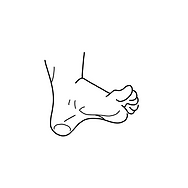
Sensory
Duration
Type
Team
My Role
3 Months
Experimental Sneaker Design
Johnny Lin, Penny Yu, Chen Tseng, Hilly Lin
Design Research, Sneaker Design
Overview
An Experimental Project in Collaboration with Nike
In the innovation department of Pou Chen, only one out of ten experimental projects are transformed into commercial products and released to markets. Sensory was one of them.
The project featured flexible “touch pods” that function like pistons, allowing futsal players to feel the ball.


Background
Touch Pods vs. Sensation
The project’s direction was given by Nike headquarters: use touch pods to provide additional sensation to futsal players. With reference to pressure mapping showing primary underfoot touch points, the touch pods are placed accordingly and designed to give players a better sense of where the ball is underfoot.
The objective is to promote a heads-up play mode that allows for faster reactions on the pitch, negating the need to look down at the user’s feet.

Defining
Communicating with Stakeholders

Johnny Lin
Project Lead, Nike
The main objective of this project was to explore a variety of touch pods that allow wearers to feel the ball and surroundings.
“

Hilly Lin
Engineer, Pou Chen
While exploring different structures of the sole, we should consider whether the structure is feasible and waterproof.
“

Penny Yu
Project Manager, Pou Chen
We should focus on the concepts that can be converted to samples and verified.
“
Defining
Success Metrics
Goals



The explored structure of the sole can be manufactured under current technology constraints.
Users are able to feel the ball and the ups downs of roads while wearing the shoes.
Users are comfortable and still can move freely when wearing the shoes.
Signals
The concept can be made as a sample at the Pou Chen factory.
Metrics
Sample conversion rate
Users can detect the specific areas where they have underfoot sensation.
Underfoot awareness rate
Users find it easy to try on the shoes and are willing to wear them for a long period of time.
Average wearing time
Designing
Moodboard
We collected images that relate to sensation and tactility, to be inspired by a wide range of forms and materials.
From the selected data, we learned that changing a certain material in different forms can provide various sensations, and placing stimulation in diverse areas can arouse different tactile senses.


Designing
Brainstorming
Based on the project’s goal and the discussions with the stakeholders, we started to brainstorm. The ideas include how to construct the sole structure that gives users a sense of touch, and how to waterproof them.
Designing
Prototypes
After brainstorming, we selected several concepts that fit the goals and can be validated through rapid prototypes.
In the first approach, there were six different sole structures, with variations of materials and forms, which aimed to test whether the structures or the materials can provide enough sensation yet be comfortable.


Designing
First Wear Test
We let colleagues try on the prototypes to see whether they can feel the movement of the pods while walking.
The result showed that they had the greatest sensation when wearing the prototypes that were constructed by relatively big pods, while they barely noticed the pods of those formed with small pods.

Designing
Iteration Based on Feedback
In this round of iterations, besides keeping the 3 cm pods in the forefoot section, we tried to enhance touch by increasing the size of pods in the heel area.
In addition, we tried different approaches on the upper material and the layout of pods, to find the best combination which can provide stability while wearing it.

Designing
Wear Test
Although we tried to cover the sole with pods in ascending order from forefoot to heel, users only could feel a few on their forefoot and were barely aware of the ones on the heel.
From this round of iteration, we learned that placing a lot of pods on the sole didn’t mean the user will sense every one of them. Therefore, we tried using limited columns and arrange them in areas that could provide a noticeable sensation.


Designing
Final Iteration and Finding
In the final iteration, we tried to arrange limited pods in several ways. From the result of the wear tests, placing maximum of 10 pods on the forefoot had the greatest touch yet maintain the stability and comfort of the shoes.
These processes and findings were shared with NIKE Headquarters.




Designing
Impact
The concept and findings we explored in the sensory project were adapted to be more suitable for daily use by Nike Headquarters and launched as Nike React Gate in 2020.
sample conversion
75%
underfoot awareness
60%
average wearing time
27%

Reflection



Avoiding bias by interacting with users
It is tempting to focus on our own ideology when developing the design. At the beginning, we focused on developing “visually distinctive” structures of pods, however, users could barely sense them. It was vital to let users try samples and get their feedback during the process, which was the best way to bypass biases and get closer to the goals.
Verifying ideas through prototyping
While imagining the ideas in our heads, everything seems ideal. We may neglect feasibility and comfortability, however, making rapid prototypes can help us test if the concept is as we imagined, and evolve it effectively through iterations.
Being agile when running projects
We worked closely with a Nike innovator for months. The direction changed frequently since it was an innovative project and we could only find the best answer through continual exploration. Therefore, we needed to be open-minded to try different possibilities and stay aligned with the stakeholders to make sure we were on the same page.